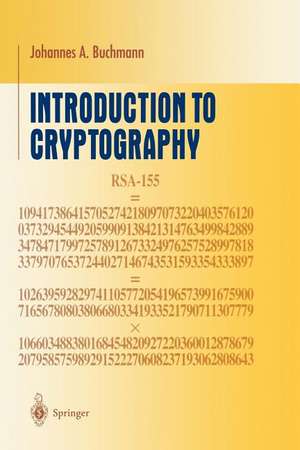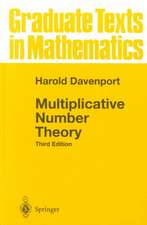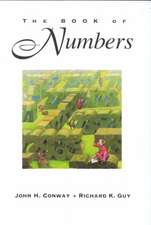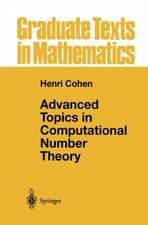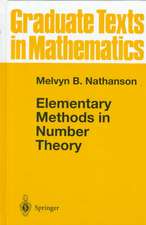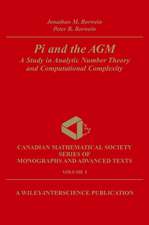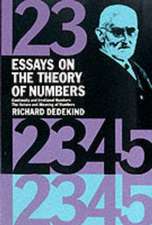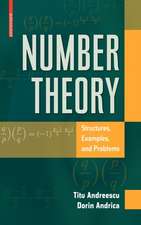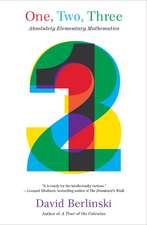Introduction to Cryptography: Undergraduate Texts in Mathematics
Autor Johannes Buchmannen Limba Engleză Paperback – 21 ian 2012
| Toate formatele și edițiile | Preț | Express |
|---|---|---|
| Paperback (2) | 388.34 lei 6-8 săpt. | |
| Springer – 21 ian 2012 | 388.34 lei 6-8 săpt. | |
| Springer – 13 iul 2004 | 474.31 lei 6-8 săpt. |
Din seria Undergraduate Texts in Mathematics
- 17%
 Preț: 362.13 lei
Preț: 362.13 lei - 17%
 Preț: 365.42 lei
Preț: 365.42 lei - 20%
 Preț: 466.83 lei
Preț: 466.83 lei -
 Preț: 400.42 lei
Preț: 400.42 lei -
 Preț: 298.00 lei
Preț: 298.00 lei -
 Preț: 364.40 lei
Preț: 364.40 lei - 8%
 Preț: 384.89 lei
Preț: 384.89 lei -
 Preț: 257.71 lei
Preț: 257.71 lei - 17%
 Preț: 395.93 lei
Preț: 395.93 lei -
 Preț: 380.26 lei
Preț: 380.26 lei -
 Preț: 339.36 lei
Preț: 339.36 lei -
 Preț: 372.26 lei
Preț: 372.26 lei -
 Preț: 370.77 lei
Preț: 370.77 lei -
 Preț: 440.01 lei
Preț: 440.01 lei -
 Preț: 402.33 lei
Preț: 402.33 lei - 17%
 Preț: 366.38 lei
Preț: 366.38 lei -
 Preț: 433.85 lei
Preț: 433.85 lei -
 Preț: 290.80 lei
Preț: 290.80 lei - 19%
 Preț: 368.78 lei
Preț: 368.78 lei -
 Preț: 400.42 lei
Preț: 400.42 lei - 19%
 Preț: 400.52 lei
Preț: 400.52 lei -
 Preț: 359.48 lei
Preț: 359.48 lei -
 Preț: 415.94 lei
Preț: 415.94 lei - 17%
 Preț: 373.59 lei
Preț: 373.59 lei -
 Preț: 407.62 lei
Preț: 407.62 lei -
 Preț: 407.96 lei
Preț: 407.96 lei -
 Preț: 358.10 lei
Preț: 358.10 lei -
 Preț: 280.65 lei
Preț: 280.65 lei - 17%
 Preț: 368.60 lei
Preț: 368.60 lei - 17%
 Preț: 367.24 lei
Preț: 367.24 lei -
 Preț: 395.09 lei
Preț: 395.09 lei -
 Preț: 424.14 lei
Preț: 424.14 lei -
 Preț: 304.91 lei
Preț: 304.91 lei - 13%
 Preț: 389.61 lei
Preț: 389.61 lei - 17%
 Preț: 362.67 lei
Preț: 362.67 lei - 15%
 Preț: 417.73 lei
Preț: 417.73 lei -
 Preț: 332.02 lei
Preț: 332.02 lei -
 Preț: 329.94 lei
Preț: 329.94 lei - 19%
 Preț: 492.82 lei
Preț: 492.82 lei -
 Preț: 396.24 lei
Preț: 396.24 lei -
 Preț: 390.08 lei
Preț: 390.08 lei - 15%
 Preț: 521.04 lei
Preț: 521.04 lei -
 Preț: 402.00 lei
Preț: 402.00 lei - 15%
 Preț: 531.72 lei
Preț: 531.72 lei - 15%
 Preț: 447.81 lei
Preț: 447.81 lei
Preț: 388.34 lei
Nou
Puncte Express: 583
Preț estimativ în valută:
74.31€ • 77.58$ • 61.50£
74.31€ • 77.58$ • 61.50£
Carte tipărită la comandă
Livrare economică 05-19 aprilie
Preluare comenzi: 021 569.72.76
Specificații
ISBN-13: 9781468404982
ISBN-10: 1468404989
Pagini: 300
Ilustrații: XI, 281 p.
Dimensiuni: 155 x 235 x 16 mm
Greutate: 0.42 kg
Ediția:Softcover reprint of the original 1st ed. 2001
Editura: Springer
Colecția Springer
Seria Undergraduate Texts in Mathematics
Locul publicării:New York, NY, United States
ISBN-10: 1468404989
Pagini: 300
Ilustrații: XI, 281 p.
Dimensiuni: 155 x 235 x 16 mm
Greutate: 0.42 kg
Ediția:Softcover reprint of the original 1st ed. 2001
Editura: Springer
Colecția Springer
Seria Undergraduate Texts in Mathematics
Locul publicării:New York, NY, United States
Public țintă
GraduateCuprins
1 Integers.- 1.1 Basics.- 1.2 Divisibility.- 1.3 Representation of Integers.- 1.4 O- and ?-Notation.- 1.5 Cost of Addition, Multiplication, and Division with Remainder.- 1.6 Polynomial Time.- 1.7 Greatest Common Divisor.- 1.8 Euclidean Algorithm.- 1.9 Extended Euclidean Algorithm.- 1.10 Analysis of the Extended Euclidean Algorithm.- 1.11 Factoring into Primes.- 1.12 Exercises.- 2 Congruences and Residue Class Rings.- 2.1 Congruences.- 2.2 Semigroups.- 2.3 Groups.- 2.4 Residue Class Rings.- 2.5 Fields.- 2.6 Division in the Residue Class Ring.- 2.7 Analysis of Operations in the Residue Class Ring.- 2.8 Multiplicative Group of Residues.- 2.9 Order of Group Elements.- 2.10 Subgroups.- 2.11 Fermat’s Little Theorem.- 2.12 Fast Exponentiation.- 2.13 Fast Evaluation of Power Products.- 2.14 Computation of Element Orders.- 2.15 The Chinese Remainder Theorem.- 2.16 Decomposition of the Residue Class Ring.- 2.17 A Formula for the Euler ?-Function.- 2.18 Polynomials.- 2.19 Polynomials over Fields.- 2.20 Structure of the Unit Group of Finite Fields.- 2.21 Structure of the Multiplicative Group of Residues mod a Prime Number.- 2.22 Exercises.- 3 Encryption.- 3.1 Encryption Schemes.- 3.2 Symmetric and Asymmetric Cryptosystems.- 3.3 Cryptanalysis.- 3.4 Alphabets and Words.- 3.5 Permutations.- 3.6 Block Ciphers.- 3.7 Multiple Encryption.- 3.8 Use of Block Ciphers.- 3.9 Stream Ciphers.- 3.10 Affine Cipher.- 3.11 Matrices and Linear Maps.- 3.12 Affine Linear Block Ciphers.- 3.13 Vigenère, Hill, and Permutation Ciphers.- 3.14 Cryptanalysis of Affine Linear Block Ciphers.- 3.15 Exercises.- 4 Probability and Perfect Secrecy.- 4.1 Probability.- 4.2 Conditional Probability.- 4.3 Birthday Paradox.- 4.4 Perfect Secrecy.- 4.5 Vernam One-Time Pad.- 4.6 Random Numbers.- 4.7 PseudorandomNumbers.- 4.8 Exercises.- 5 DES.- 5.1 Feistel Ciphers.- 5.2 DES Algorithm.- 5.3 An Example.- 5.4 Security of DES.- 5.5 Exercises.- 6 Prime Number Generation.- 6.1 Trial Division.- 6.2 Fermat Test.- 6.3 Carmichael Numbers.- 6.4 Miller-Rabin Test.- 6.5 Random Primes.- 6.6 Exercises.- 7 Public-Key Encryption.- 7.1 Idea.- 7.2 RSA Cryptosystem.- 7.3 Rabin Encryption.- 7.4 Diffie-Hellman Key Exchange.- 7.5 ElGamal Encryption.- 7.6 Exercises.- 8 Factoring.- 8.1 Trial Division.- 8.2 p — 1 Method.- 8.3 Quadratic Sieve.- 8.4 Analysis of the Quadratic Sieve.- 8.5 Efficiency of Other Factoring Algorithms.- 8.6 Exercises.- 9 Discrete Logarithms.- 9.1 DL Problem.- 9.2 Enumeration.- 9.3 Shanks Baby-Step Giant-Step Algorithm.- 9.4 Pollard ?-Algorithm.- 9.5 Pohlig-Hellman Algorithm.- 9.6 Index Calculus.- 9.7 Other Algorithms.- 9.8 Generalization of the Index Calculus Algorithm.- 9.9 Exercises.- 10 Cryptographic Hash Functions.- 10.1 Hash Functions and Compression Functions.- 10.2 Birthday Attack.- 10.3 Compression Functions from Encryption Functions.- 10.4 Hash Functions from Compression Functions.- 10.5 Efficient Hash Functions.- 10.6 An Arithmetic Compression Function.- 10.7 Message Authentication Codes.- 10.8 Exercises.- 11 Digital Signatures.- 11.1 Idea.- 11.2 RSA Signatures.- 11.3 Signatures from Public-Key Systems.- 11.4 ElGamal Signature.- 11.5 Digital Signature Algorithm (DSA).- 11.6 Exercises.- 12 Other Groups.- 12.1 Finite Fields.- 12.2 Elliptic Curves.- 12.3 Quadratic Forms.- 12.4 Exercises.- 13 Identification.- 13.1 Passwords.- 13.2 One-Time Passwords.- 13.3 Challenge-Response Identification.- 13.4 Exercises.- 14 Public-Key Infrastructures.- 14.1 Personal Security Environments.- 14.2 Certification Authorities.- 14.3 Certificate Chains.- References.- Solutions to theExercises.
Textul de pe ultima copertă
Cryptography is a key technology in electronic key systems. It is used to keep data secret, digitally sign documents, access control, etc. Therefore, users should not only know how its techniques work, but they must also be able to estimate their efficiency and security. For this new edition, the author has updated the discussion of the security of encryption and signature schemes and recent advances in factoring and computing discrete logarithms. He has also added descriptions of time-memory trade of attacks and algebraic attacks on block ciphers, the Advanced Encryption Standard, the Secure Hash Algorithm, secret sharing schemes, and undeniable and blind signatures.
Johannes A. Buchmann is a Professor of Computer Science and Mathematics at the Technical University of Darmstadt, and the Associate Editor of the Journal of Cryptology. In 1985, he received the Feodor Lynen Fellowship of the Alexander von Humboldt Foundation. Furthermore, he has received the most prestigious award in science in Germany, the Leibniz Award of the German Science Foundation.
About the first edition:
It is amazing how much Buchmann is able to do in under 300 pages: self-contained explanations of the relevant mathematics (with proofs); a systematic introduction to symmetric cryptosystems, including a detailed description and discussion of DES; a good treatment of primality testing, integer factorization, and algorithms for discrete logarithms; clearly written sections describing most of the major types of cryptosystems....This book is an excellent reference, and I believe it would also be a good textbook for a course for mathematics or computer science majors..."
-Neal Koblitz, The American Mathematical Monthly
Johannes A. Buchmann is a Professor of Computer Science and Mathematics at the Technical University of Darmstadt, and the Associate Editor of the Journal of Cryptology. In 1985, he received the Feodor Lynen Fellowship of the Alexander von Humboldt Foundation. Furthermore, he has received the most prestigious award in science in Germany, the Leibniz Award of the German Science Foundation.
About the first edition:
It is amazing how much Buchmann is able to do in under 300 pages: self-contained explanations of the relevant mathematics (with proofs); a systematic introduction to symmetric cryptosystems, including a detailed description and discussion of DES; a good treatment of primality testing, integer factorization, and algorithms for discrete logarithms; clearly written sections describing most of the major types of cryptosystems....This book is an excellent reference, and I believe it would also be a good textbook for a course for mathematics or computer science majors..."
-Neal Koblitz, The American Mathematical Monthly
Recenzii
From the reviews:
Zentralblatt Math
"[......] Of the three books under review, Buchmann's is by far the most sophisticated, complete and up-to-date. It was written for computer-science majors - German ones at that - and might be rough going for all but the best American undergraduates. It is amazing how much Buchmann is able to do in under 300 pages: self-contained explanations of the relevant mathematics (with proofs); a systematic introduction to symmetric cryptosystems, including a detailed description and discussion of DES; a good treatment of primality testing, integer factorization, and algorithms for discrete logarithms, clearly written sections describing most of the major types of cryptosystems, and explanations of basic concepts of practical cryptography such as hash functions, message authentication codes, signatures, passwords, certification authorities, and certificate chains. This book is an excellent reference, and I believe that it would also be a good textbook for a course for mathematics or computer science majors, provided that the instructor is prepared to supplement it with more leisurely treatments of some of the topics."
N. Koblitz (Seattle, WA) - American Math. Society Monthly.
J.A. Buchmann
Introduction to Cryptography
"It gives a clear and systematic introduction into the subject whose popularity is ever increasing, and can be recommended to all who would like to learn about cryptography. The book contains many exercises and examples. It can be used as a textbook and is likely to become popular among students. The necessary definitions and concepts from algebra, number theory and probability theory are formulated, illustrated by examples and applied to cryptography." —ZENTRALBLATT MATH
"For those of use who wish to learn more about cryptography and/or to teach it, Johannes Buchmann has written this book. … The book is mathematicallycomplete and a satisfying read. There are plenty of homework exercises … . This is a good book for upperclassmen, graduate students, and faculty. … This book makes a superior reference and a fine textbook." (Robert W. Vallin, MathDL, January, 2001)
"Buchmann’s book is a text on cryptography intended to be used at the undergraduate level. … the intended audiences of this book are ‘readers who want to learn about modern cryptographic algorithms and their mathematical foundations … . I enjoy reading this book. … Readers will find a good exposition of the techniques used in developing and analyzing these algorithms. … These make Buchmann’s text an excellent choice for self study or as a text for students … in elementary number theory and algebra." (Andrew C. Lee, SIGACT News, Vol. 34 (4), 2003)
From the reviews of the second edition:
"This is the english translation of the second edition of the author’s prominent german textbook ‘Einführung in die Kryptographie’. The original text grew out of several courses on cryptography given by the author at the Technical University Darmstadt; it is aimed at readers who want to learn about modern cryptographic techniques and its mathematical foundations … . As compared with the first edition the number of exercises has almost been doubled and some material … has been added." (R. Steinbauer, Monatshefte für Mathematik, Vol. 150 (4), 2007)
Zentralblatt Math
"[......] Of the three books under review, Buchmann's is by far the most sophisticated, complete and up-to-date. It was written for computer-science majors - German ones at that - and might be rough going for all but the best American undergraduates. It is amazing how much Buchmann is able to do in under 300 pages: self-contained explanations of the relevant mathematics (with proofs); a systematic introduction to symmetric cryptosystems, including a detailed description and discussion of DES; a good treatment of primality testing, integer factorization, and algorithms for discrete logarithms, clearly written sections describing most of the major types of cryptosystems, and explanations of basic concepts of practical cryptography such as hash functions, message authentication codes, signatures, passwords, certification authorities, and certificate chains. This book is an excellent reference, and I believe that it would also be a good textbook for a course for mathematics or computer science majors, provided that the instructor is prepared to supplement it with more leisurely treatments of some of the topics."
N. Koblitz (Seattle, WA) - American Math. Society Monthly.
J.A. Buchmann
Introduction to Cryptography
"It gives a clear and systematic introduction into the subject whose popularity is ever increasing, and can be recommended to all who would like to learn about cryptography. The book contains many exercises and examples. It can be used as a textbook and is likely to become popular among students. The necessary definitions and concepts from algebra, number theory and probability theory are formulated, illustrated by examples and applied to cryptography." —ZENTRALBLATT MATH
"For those of use who wish to learn more about cryptography and/or to teach it, Johannes Buchmann has written this book. … The book is mathematicallycomplete and a satisfying read. There are plenty of homework exercises … . This is a good book for upperclassmen, graduate students, and faculty. … This book makes a superior reference and a fine textbook." (Robert W. Vallin, MathDL, January, 2001)
"Buchmann’s book is a text on cryptography intended to be used at the undergraduate level. … the intended audiences of this book are ‘readers who want to learn about modern cryptographic algorithms and their mathematical foundations … . I enjoy reading this book. … Readers will find a good exposition of the techniques used in developing and analyzing these algorithms. … These make Buchmann’s text an excellent choice for self study or as a text for students … in elementary number theory and algebra." (Andrew C. Lee, SIGACT News, Vol. 34 (4), 2003)
From the reviews of the second edition:
"This is the english translation of the second edition of the author’s prominent german textbook ‘Einführung in die Kryptographie’. The original text grew out of several courses on cryptography given by the author at the Technical University Darmstadt; it is aimed at readers who want to learn about modern cryptographic techniques and its mathematical foundations … . As compared with the first edition the number of exercises has almost been doubled and some material … has been added." (R. Steinbauer, Monatshefte für Mathematik, Vol. 150 (4), 2007)
Notă biografică
Johannes A. Buchmann is Professor of Computer Science and Mathematics at the Technical University of Darmstadt, and an Associate Editor of the Journal of Cryptology. In 1985, he received a Feodor Lynen Fellowship of the Alexander von Humboldt Foundation. He has also received the most prestigious award in science in Germany, the Leibniz Award of the German Science Foundation (Deutsche Forschungsgemeinschaft).
Caracteristici
Includes supplementary material: sn.pub/extras
